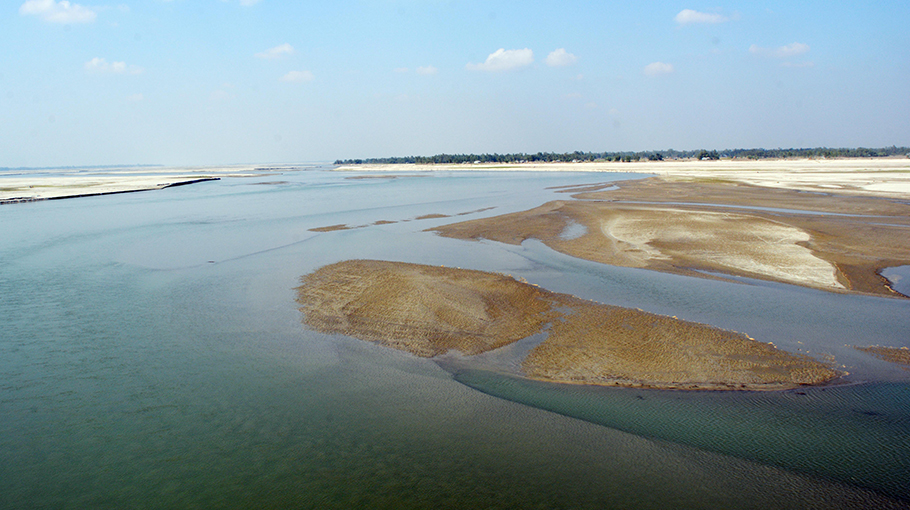International Rivers Day
50 rivers in death throe in Rangpur Region


Bangladesh is known as a riverine country once. But the rivers of this riverine country are now turning into dead canals with change of time.
March 14 is International Rivers Day. People of Rangpur Region have forgotten the name of Ichhamati where the city was formed. Due to illegal establishment about 50 rivers in the region have lost their navigability.
As the neighboring country stop water flow especially in summer season, those rive are now turned into dried field. But even half a century ago, these rivers had the flow of water and the vibration of life. Now the existence of the river is lost in the ebb and flow. And it is having a negative impact on various fields including agriculture and environment.
The Rangpur Mahiganj port city was formed on the banks of Ichhamati River, it was a center trading point of the region. When the river Teesta changed its course due to heavy rains and floods in 1887, the flow of Ichhamati started to decrease. It was learned that Pir Hazrat Shahjalal Bukhari (Rah.) Came to Mahiganj through Ichhamati River in a fish-like boat, hence the name of the area become Mahiganj from Mahiswar.
At present the name of this river is not in the list of Bangladesh Water Development Board. The river is connected to Shyamasundari canal west of Mahiganj. To the north-west of Mahiganj, there is another end to the Nachniya Bill. The concern authority has never taken any initiative to save the river. New generation those who have built new settlements along this river do not know the name of this river.
Director of Riverine People and Begum Rokeya University’s Bangla Professor Dr Tuhin Wadud is working to save rivers for a long time. He said, “Ichhamati is a traditional river. The development of Rangpur culture and civilization is involved to this river. We must save such river. It is possible to enjoy the beauty of this river not only in monsoon season but also in all season if the concerned authority works to protect and develop them.”
According to the investigation, the oldest towns in the north are Rangpur, Gaibandha, Lalmonirhat, Kurigram, Nilphamari, Dinajpur, Panchagarh and Thakurgaon districts of Rangpur region. About 50 rivers including Sonavhari, Halhalia, Lahita, Ghargharia, Naleya, Jinjiram, Fulkumar, Kantkhali, Sarmara, Raydhak, Yamuneshwari, Chitni, Mara Karatoya, Ichhamati, Alai, Ghaghat, Teesta, Kumari are now dead. Most of these rivers are now not navigable. At present, the water in some rivers has dried up. People used to cross these rivers in sailing boats but now people are walking on foot.
The image of Teesta in the dry season is also very bad. The lowest water flow of all time is now in Teesta. As a result of unilateral withdrawal of water, this 112 mile long river of Bangladesh has dried up and is
now dying.
The Karatoya River, which used to hold a terrible appearance even in light rain is now dying due to lack of water. Although the current of this river tried to gain some momentum by entering Gaibandha and Bogura, but now it is just history. The Alaikuri River, which once flowed through Pirgachha upazila of Rangpur, has now turned into a dead canal.
The Ghaghat River flowing over Gangachara in Rangpur is dying in the cycle of time. Due to dehydration, various crops are being planted in the river. And after a few years, this river will be lost from the history. People are forcibly occupying the land. Hundreds of fishermen have become unemployed due to the drying up of the river. Experienced people think that if the River is dug, irrigation can be arranged in the cultivable land including fish farming. This will benefit the farmers.
It is known that Ghaghat River originated as a tributary of Teesta River in Kujipara village of Kishoreganj upazila of Nilphamari district. The Ghaghat River enters Pirgachha Upazila through Rangpur Sadar through Nohali, Alambiditar and Betgari Unions along the western boundary of Gangachara Upazila. It then joins the Alaikuri River at Jamuna via Sadullapur in Gaibandha district.
120 km of the river has dried up. According to the locals, sailing boats used to sail on this river. Merchants came from far and wide to do business. People used to supply different types of goods by river. In the dry season of that river, the water flow is now at zero.




